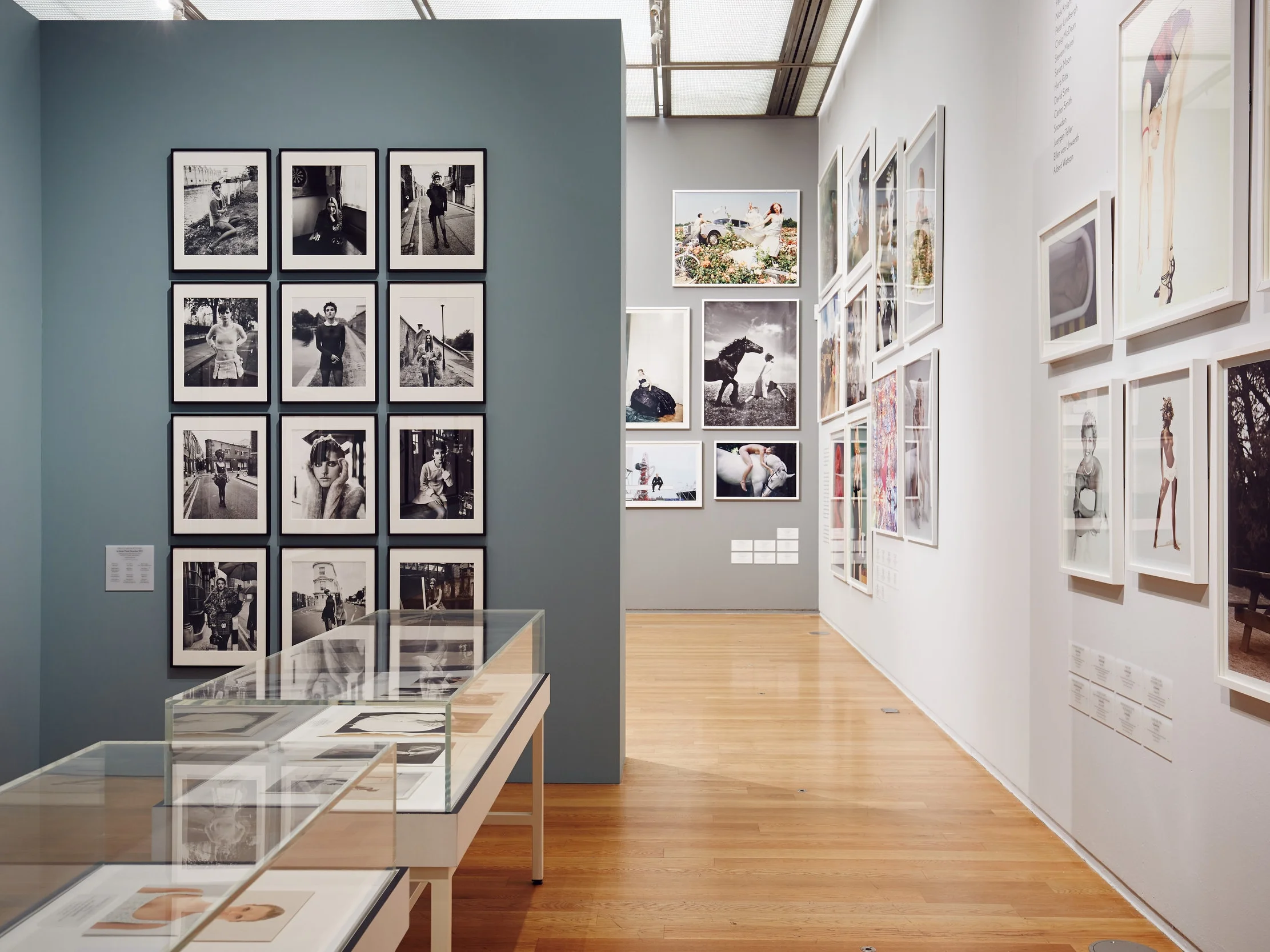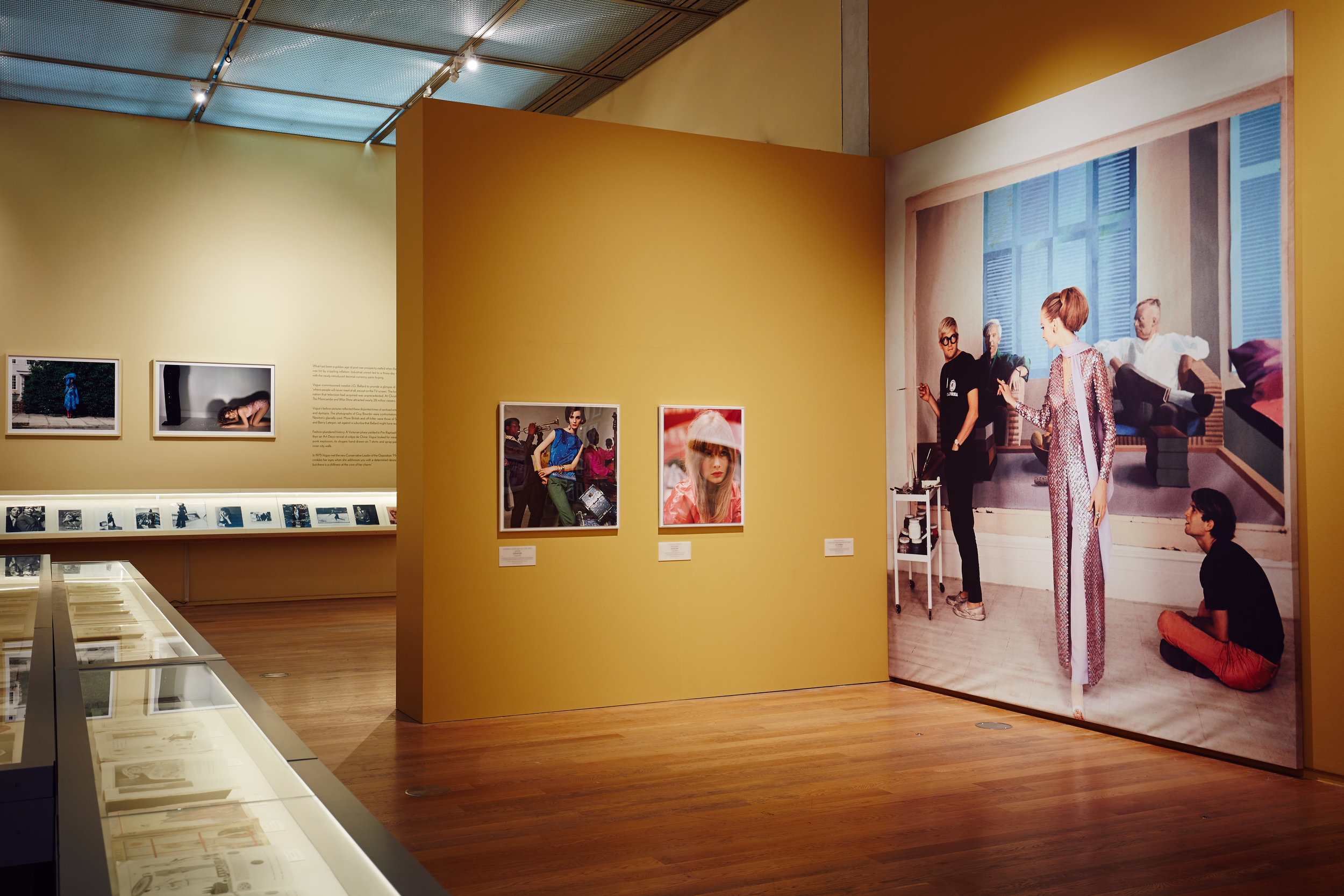Exhibition Review: Vogue 100: A Century of Style
Manchester Art Gallery (Manchester, UK) June 24–October 30, 2016
Vogue 100: A Century of Style, curated by British Vogue’s Contributing Editor Robin Muir, was presented for the first time at London’s National Portrait Gallery, before travelling to the Manchester Art Gallery in the north of England. Although the design of the exhibition has been adapted, the selection of images and presentation have remained consistent. Perhaps more importantly, however, in both instances the exhibition’s setting in traditional art institutions inevitably recalls the ancient debate about fashion’s relationship with art. It does so in a particularly striking way in Manchester, however, as the museum is best known for its fine selection of pre-Raphaelite painting and English art from between the 19th and the 20th century, rather than for an interest in contemporary fashion.
As its title suggests, the exhibition sets out to celebrate Vogue’s first 100 years and it does so through a selection of over 280 iconic photographs from issues published between 1916 and 2016. These strictly copyrighted images – determining the impossibility for visitors to use cameras at the exhibition – come mainly from the Condé Nast archive, but also from other collections including that of the National Portrait Gallery and private ones. In presenting the history of a century of Vogue through the work of the most iconic photographers, models, and designers that have appeared within its pages, the exhibition sheds light on the significance of Vogue in the life of its readers, and on its role in creating a fashion consciousness and promoting aspirational lifestyles. This is done with an often emotional tone – it is after all a celebration of the magazine’s first century – that is particularly evident in the introduction to the exhibition catalogue. A beautifully written personal narration by Polly Devlin, this introductory text describes the particular lure of the storied publication:
"When I opened my expensive treasure, I entered a make-believe place where all was light and gleam and unreality: the lights in the studio, the shine on the pearls, the glimmer of the taffeta, the sheen of blond curls on a flower-line neck. At home everything was shapeless – women, animals, houses, food and me – and timidity was admired, but in these pages life was limned, shapely, elegant, epigrammatic, artificial and supremely confident."
However, in spite of the exhibition’s lyrical approach to Vogue’s photography, authorship, and function as a meter of taste, the tone of the exhibition is not one that ignores the historical, economic, and geographical conditions in which British Vogue and its contents were produced. The exhibition is replete with images highlighting social change in Britain, often making reference to the political contexts that produced it. This is done, for example, when presenting Lee Miller’s photography during World War II and its reception by women on the home front. Margaret Thatcher appears often, both in her role as Prime Minister in the 80s and as leader of the opposition in the 70s. In both instances, Vogue’s photographs of her function to signpost rising individualism in British society, which is also manifested both in the era’s fashions and through Vogue’s photography. Another more recent example is the image of former London mere Boris Johnson from an issue of 2012: a conspicuous inclusion in the most recent section, this is an image that certainly provoked visitors regardless of their feelings regarding Britain’s recent referendum to stay in or leave the European Union.
The 100-year history is delivered chronologically, but in reverse order. Since the 70s curators of contemporary art have explored new patterns of temporality, often producing exhibitions that escape the linearity of traditional chronologies. These approaches are situated against traditional historical conventions: they question the past and favor hermeneutical understandings of history as an endless interweaving of events and narratives. Their development came as museums and galleries sought to produce exhibitions as sentient experiences of collections in order to find a balance between education and entertainment. The choice to tell Vogue’s story through the lens of the present is an original and effective one: the result is an historical exploration in which the visitor’s own memories, experiences, and perceptions of historical moments serve as a personal meter of the magazine’s history. At the Vogue 100 exhibition, every visitor can thus relate to Vogue’s images and popular culture icons from the beginning of the exhibition, thereby activating a consciousness of fashion and its icons that the magazine has helped to develop over the past century. The experience therefore becomes an almost “archeological” one.
As anticipated, the process of remediation through which Vogue’s images are printed in archival ink and are framed as museum-worthy works of art inevitably recalls the often heated debates regarding fashion’s relationship with art. This also includes an understanding of fashion photography as art, and of whether the methodologies of art can be used to study and exhibit dress. Being that the magazine as a medium has defined how we perceive fashion imagery, the challenge in presenting these photographic works in an art museum lies in defining their relationship to art itself. Manchester Art Gallery contributed to this debate in1997, when it hosted a conference titled “Dress in History: Studies and Approaches” at its Gallery of Costume—which also houses one of the most extensive and impressive dress collections in the UK.[1] Retrospectively, the conference stands as a key event in the development of fashion studies as a critical discipline that makes a methodological departure from the object-based approaches of art history. This was an important conference also because it came at a time when cultural heritage institutions were already redefining their purposes and strategies by embracing new art historical thinking and the thrust of the new museology debates. In a later paper on the interdisciplinary of fashion research, Christopher Breward speaks of the legacy Manchester conference, arguing that it highlighted a “great disjunction” between object-focused curators and scholars of cultural studies. As Breward writes,
“protagonists from both sides seemed to become more deeply entrenched in the comforting prejudices of their own familiar points of reference—refusing to countenance the ideas of the opposing camp, insults were traded, and even the proceedings of the conference were published along the fault-lines of the schism—half in the recently launched Fashion Theory and half in the long established journal Costume.”[2]
However, as Breward also points out in the same paper, this is not the binary world of 1998 and the division that became evident at that time seems outdated.
In light of this, at least two options emerge in trying to interpret the presence of Vogue 100 at Manchester Art Gallery. On the one hand, the visitor might be tempted to naively see it as the institution’s reiteration of the old question about the relationship between fashion and art. On the other hand, the less reductive alternative is to see the exhibition as the gallery’s effort to relocate itself in the minds of visitors as an institution that is not only dedicated to the study and display of fine art, but is also a space for exploring the broader history of visual culture. The latter signals an understanding of fashion as its own field unto itself, and also as a complex aesthetic discourse, which may be compared to those of art without being defined as such. This understanding of fashion as a field that is able to interact with others emerges also through some of the texts that accompany the exhibition. Indeed, wall texts emphasize Vogue’s long-time interest in contemporary art (e.g. the modernist works of Picasso, Cocteau, and Delaunay in their time), as well as its frequent artistic collaborations(e.g. when Cindy Sherman served as guest fashion editor in 2003).
From this perspective, the redisplay of Vogue 100 at Manchester Art Gallery will probably be looked at by future critics as evidence of the institution’s self-reinvention. It is admirable, but also timely, that such a large and established institution is seeking to reduce the conceptual division between art and fashion – a division that it had previously produced through its strict material and cultural separation of its art and dress collections .This opening up is also demonstrated by the co-presence other exhibitions not exclusively dedicated to the display of fine art. Alongside Vogue 100, an exhibition entitled Modern Japanese Design presents fashion and furniture alongside works on paper, thus demonstrating the breadth of the museum’s collection. Vogue 100 also comes at a moment of transformation in the Manchester art scene more generally as various institutions (including HOME and the Whitworth) are taking the modernization of their buildings as occasions to reinvent themselves. I therefore make a personal plea for the inclusion of more fashion exhibitions within these spaces as the cosmopolitan inhabitants of Manchester still need to travel to London in order to enjoy them on a regular basis.
Notes
[1] As a reference to Manchester Art Gallery’s collection at Platt Hall Manchester’s Vogue 100 also features Schiapparelli’s summer 1937 Rococo Scrollwork dress and jacket – the exhibition only dress – strategically used in the section dedicated to Vogue’s photography during the 30s to invite visitors to visit the museum’s Costume Gallery.
[2] Christopher Breward, ‘Between the Museum and the Academia: Fashion Research and its Constituencies’, Fashion Theory 12.1 (2008): 84.
(Thumbnail Image Credit: Nathan Chandler)



